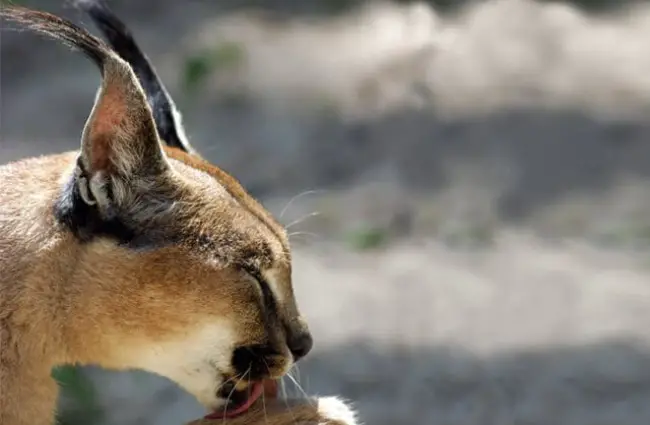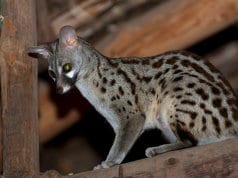The caracal is the largest of Africa’s small wildcats, but stands no more than 2 feet (.5 meter) tall. What the caracal lacks in size, it makes up for in incredible abilities. This mighty cat can leap almost 10 feet (3 meters) into the air to catch flying birds of prey, and is not afraid to take on larger mammals, even those that are three times its size. Read on to learn about the caracal.
Description of the Caracal
The caracal sports a short, dense hair coat, seen in colors of tawny-brown (most common), brick red, and (rarely) black. The most distinctive characteristic of the caracal is its ears. Each ear is topped with a long, black tuft of hair, which is approximately 1.5 inches (4 cm) long. The underbelly, throat, and chin of the caracal are white, with pale blotches of red at the inner thighs and belly.
Narrow, black stripes distinctively run down from the eyes to the nose of the caracal, as well as down the middle of the forehead. The caracal’s eyes are a yellow-brown color that do not appear as slits, as they do in other wildcats.
The male caracal cat can weigh up to 40 pounds (18 kg), whereas the females weight slightly less at an average of 35 pounds (16 kg). From the shoulder, these cats stand about 16-20 inches (40-50 cm) tall, and can be 35-39 inches (88-99 cm) long.
Interesting Facts about the Caracal
The caracal gets its name from the Turkish word “karakulak,” which means “black ear..” Additional interesting facts about the caracal :
- Extraordinary Jumper – The caracal can leap almost 10 feet (3 meters) into the air to catch birds of prey.
- Fastest Wildcat – The caracal is the fastest wildcat of its size.
- Small but deadly – The caracal can tackle prey three times its size.
The caracal’s impressive hunting abilities sparked an interest in the people of India and Iran, who trained them to hunt birds. Caracal bird hunting became something of a sport, and bets were often placed on the mighty cats, as to which cat would catch the most birds. The average number of flying birds a caracal could catch was 10-12 in one sporting event.
Habitat of the Caracal
The caracal prefers to live in the woodland and drier savannah regions of sub-Saharan Africa. It can also be found in arid mountain evergreen forests. The caracal does not, however, inhabit any tropical rain forests.
Distribution of the Caracal
The caracal can be found in geographical regions of the Middle East, Southwest Asia, West Africa, South Africa, and Central Africa.
Diet of the Caracal
Caracals are carnivores, meaning they eat meat, so their common prey includes a variety of mammals. Antelope, hyraxes, hares, and rodents are the most common animals these cats prey upon, but they will not hesitate to attack larger prey, such as young kudu, or springbok – both of which are types of antelope – if available.
Caracal and Human Interaction
The caracal is a threat to neighboring farms, so they are often killed by humans in order to protect their livestock. In other regions of the world, this small wildcat is hunted by the local bush tribes for its meat and tough skins.
Domestication
At one time, the caracal was trained to be used as a source of entertainment, sporting games, and hunting by India and Persian royalty. Today, however, the caracal is not a commonly domesticated pet.
Does the Caracal Make a Good Pet?
The caracal is a wildcat that is not readily domesticated, due to its solitary nature and territory aggression. State laws and public safety are a concern to those who do own this cat, but ownership is not completely unheard of. Professional zoo keepers and circus entertainers are the most common people to own these cats, as a great deal of knowledge is needed in order for these cats to thrive in a false habitat.
Caracal Care
In captivity, such as zoos or wildlife preserves, the caracal is given an environment that mimics its natural habitat. Tall fences, trees, waterfalls, bodies of water, and rocks are commonly found in manmade habitats.
Behavior of the Caracal
Caracals limit their social interactions to the mating season, as these solitary creatures prefer to be by themselves. The only exception to this social behavior is the mother caracal with her kittens. Caracals are nocturnal and are rarely seen during the day.
Reproduction of the Caracal
The female caracal has a pregnancy period of approximately 80 days, giving birth to a litter of caracal kittens. The average litter size of the caracal is two, but may contain as many as four kittens. The newly born kittens have only partially opened eyes, and it takes 6-10 days for the eyes to open completely. Although kitten caracals are weaned (stop drinking their mother’s milk) at 10 weeks of age, the young caracal cats will remain under their mother’s protection for about a year, when they reach sexual maturity.




















![Red Angus Closeup of a beautiful Red Angus cowPhoto by: U.S. Department of Agriculture [pubic domain]https://creativecommons.org/licenses/by/2.0/](https://animals.net/wp-content/uploads/2020/03/Red-Angus-4-100x75.jpg)

